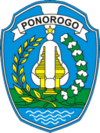Ponorogo Regency
| Ponorogo | ||
|---|---|---|
| Regency | ||
|
A demonstration of Reog Ponorogo. | ||
| ||
| Motto: Resik Endah Omber Girang Gemirang | ||
 Map of Ponorogo Regency | ||
 Ponorogo Location in Java | ||
 Ponorogo Location in Indonesia | ||
| Coordinates: 7°52′10″S 111°27′46″E / 7.86944°S 111.46278°ECoordinates: 7°52′10″S 111°27′46″E / 7.86944°S 111.46278°E | ||
| Country | Indonesia | |
| Province | East Java | |
| Capital | Ponorogo (city) | |
| Government | ||
| • Bupati | H. Amin, SH. | |
| Area | ||
| • Total | 1,305.70 km2 (504.13 sq mi) | |
| Elevation | 100 m (300 ft) | |
| Population (2014) | ||
| • Total | 879,306 | |
| • Density | 670/km2 (1,700/sq mi) | |
| Website | www.ponorogo.go.id | |
Ponorogo is one of the 29 regencies (kabupaten) of East Java, Indonesia. It is considered the birthplace of Reog Ponorogo, a traditional Indonesian dance form. The Regency covers an area of 1,305.70 sq. km, and it had a population of 855,281 at the 2010 Census;[1] the latest official estimate (as at 2014) is 879,306.
Geography
Ponorogo Regency is located in the southwestern part of the province of East Java on the border with Central Java province. It lies approximately 200 km south-west of Surabaya, the provincial capital of East Java. The regency lies between 92 and 2563 meters above sea level and covers an area of about 1,305.7 km2.
History
According to the Babad Ponorogo history, Ponorogo was founded when Bathoro Katong conquered the Wengker region. This region had previously been controlled by Suryo Ngalam Wengker. Bathoro Katong originally settled in modern-day Pekalongan in what is now the village Setono in district Jenangan. Though faced with many obstacles, Raden Katong, Aji Selo, and Ki Ageng Mirah and his family continued to establish settlements in the region.
With the consent of all parties, Bathoro Katong established the Duchy Ponorogo on 11 August 1496.[2] This date is celebrated as the founding of Ponorogo, and is corroborated by ancient objects, such as a pair of stone gilang located in front of the fifth gate of the Katong Batara tomb complex. The gilang contains the forms of a human meditating, trees, eagle and elephants (candrasengkala gilang memet); all of which combine to represent the Saka year 1496.
Culture
Ponorogo, generally considered the birthplace of Reog, is also known by the names City (of) Reog and City (of) Rasta. Each year in Muharram, Ponorogo holds a series of events called Grebeg Suro, "the party of the people". Grebeg Suro involves many traditional events such as the National Reog Festival, the Heritage Carnival and the Larungan Proceedings of Prayer, held at Lake Ngebel.
On 11 August, the anniversary of the founding of the Ponorogo Regency is celebrated. It commemorates 11 August 1496, when Bathara Katong, the first leader of Ponorogo, went from the Old Town to the Central City of Ponorogo and crowned himself the first Duke of Ponorogo.
Ponorogo is also known for its culinary specialties such as Sate Ponorogo — grilled marinated chicken – served in peanut sauce, garnished with shredded shallots, chilli paste and lime juice.
Education
Ponogoro is home to many boarding schools, in particular the Pondok Modern Darussalam Gontor, which is located in the village of Gontor in the Mlarak District.
Sport and recreation
Telaga (lake) Ngebel covers approximately 150 hectares, and is popular for jet skiing and other water sports. The lake is roughly a one-hour drive (about 30 kilometers) from Ponorogo or Madiun.[3]
Recognition
In the Otonomy Awards 2011, Ponorogo Regency received the Grand Award of Public Service Innovation.[4]
References
- ↑ Biro Pusat Statistik, Jakarta, 2011.
- ↑ Philips,, C.H., ed. (1951). Handbook of Oriental History. Royal Historical Society. p. 265. ASIN B0088L3G6I (UK).
- ↑ "Telaga ngebel - Ponorogo". Retrieved 19 December 2013.
- ↑ http://www.indopos.co.id/index.php/component/content/article/67-indo-reviews/13875-daerah-miskin-menangi-otonomi-awards-2011.pdf
External links
| Wikimedia Commons has media related to Ponorogo Regency. |
- (Indonesian) Official website
- (Indonesian) Ponorogo Online Community Forum
- (Indonesian) Paguyuban Warga Ponorogo
- (Indonesian) Kotareyog.com – Blogger Warok Ponorogo Community
- (Indonesian) Ponorogo News
| ||||||||||||||||||||||
|


